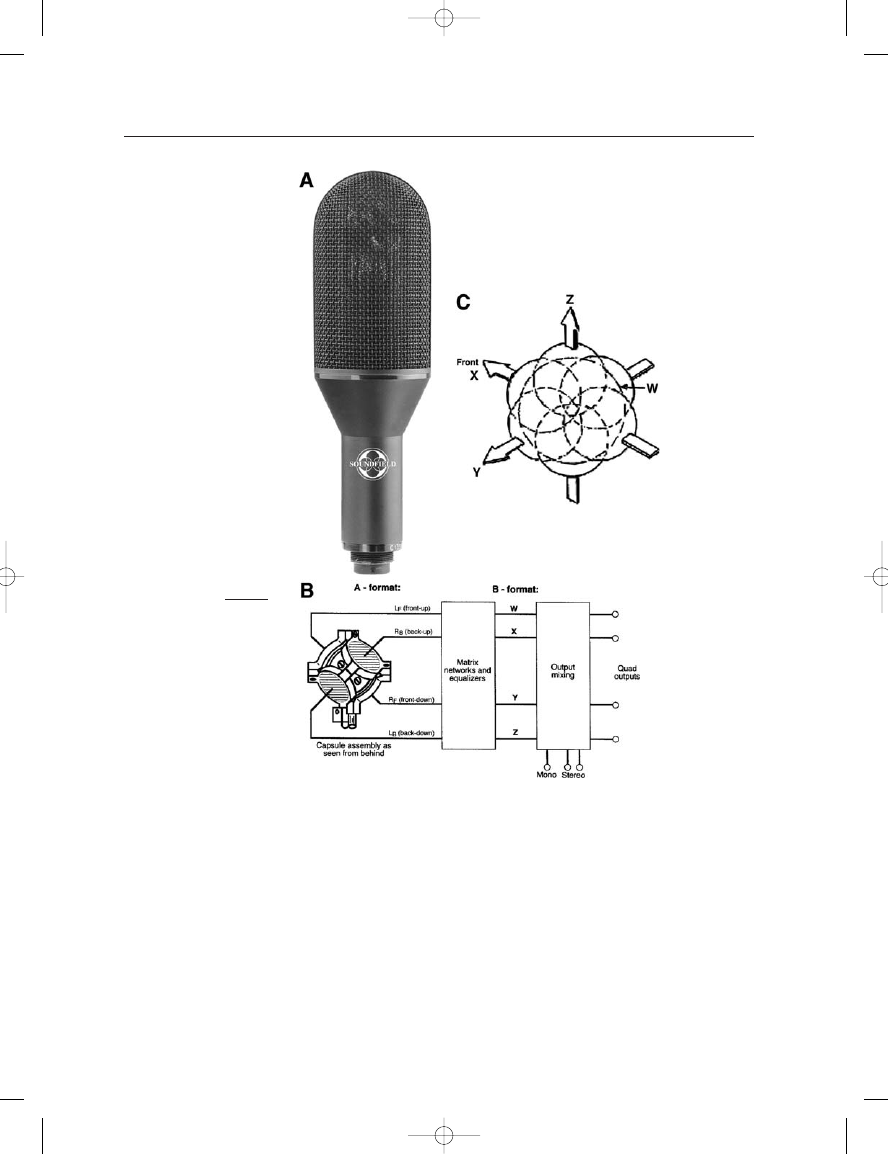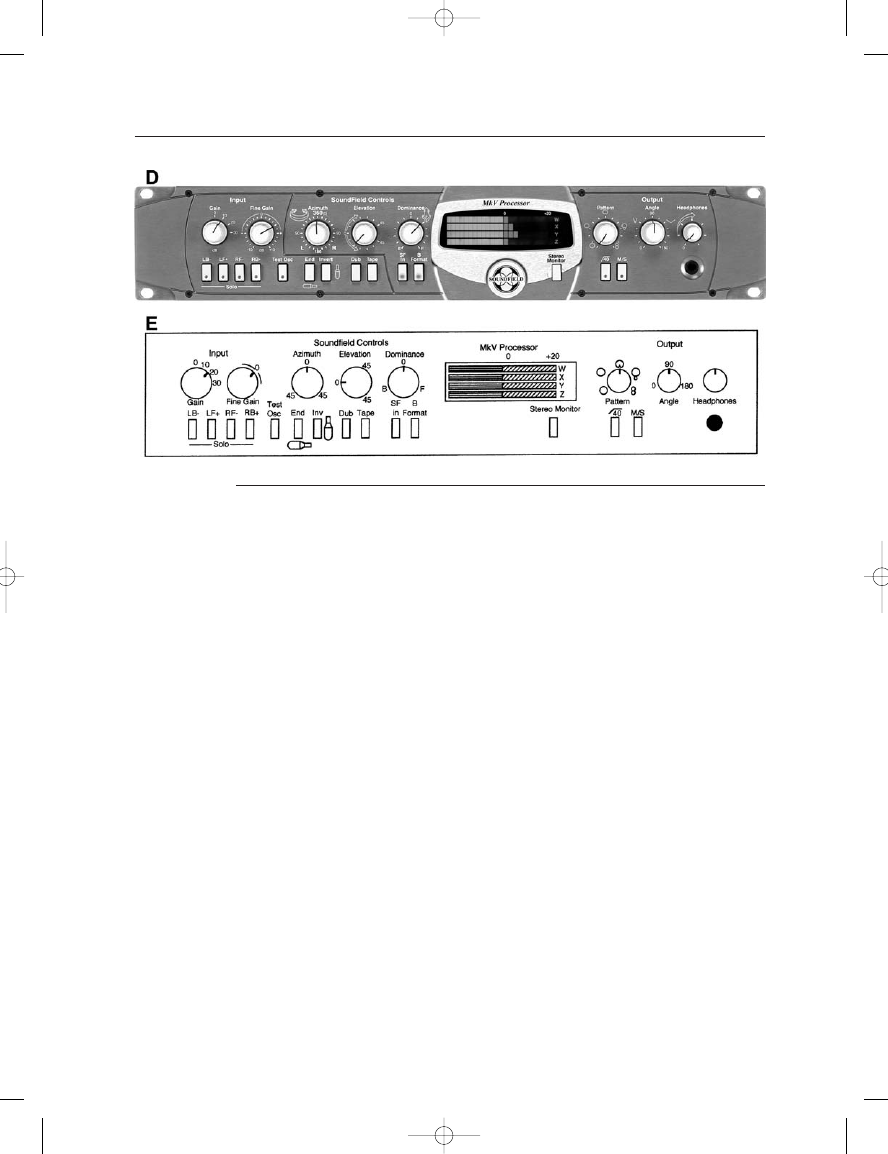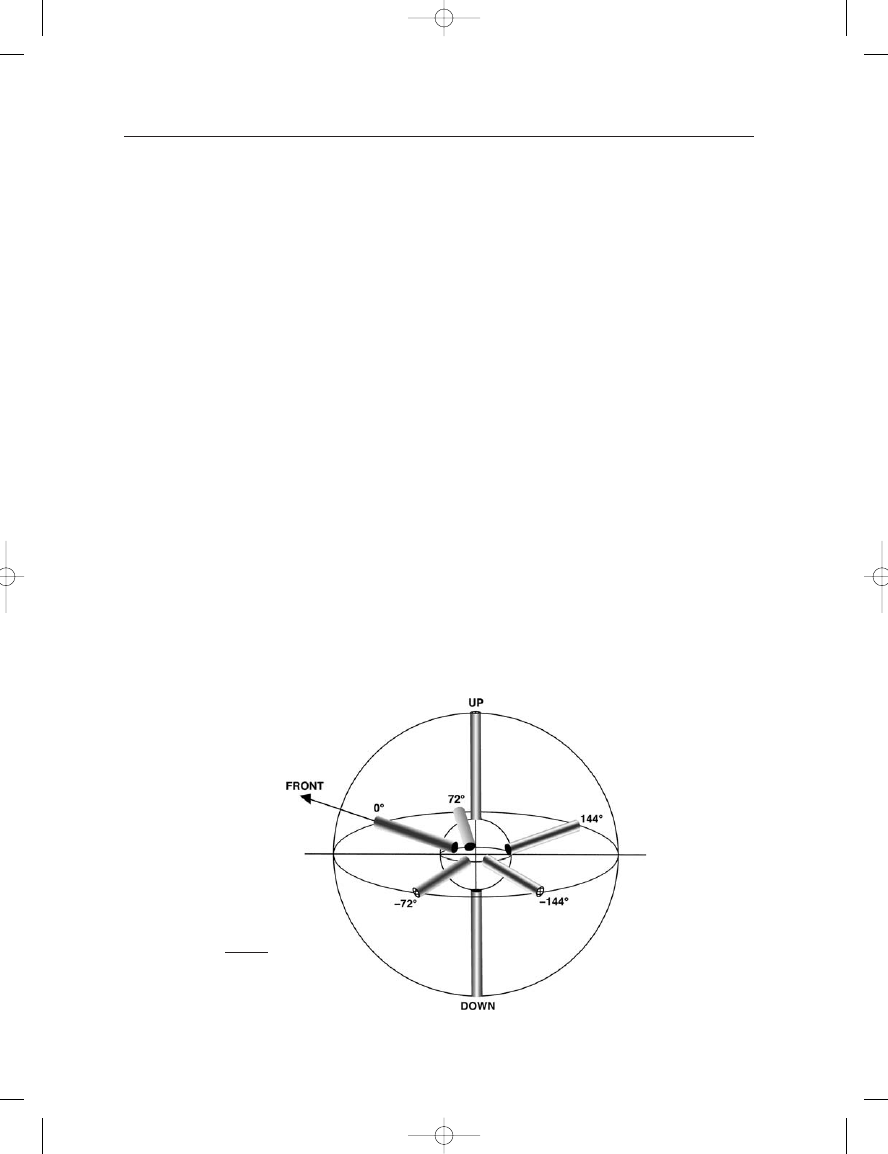ВУЗ: Казахская Национальная Академия Искусств им. Т. Жургенова
Категория: Книга
Дисциплина: Не указана
Добавлен: 03.02.2019
Просмотров: 17279
Скачиваний: 51

angle
is normally set in the range of 45, giving values of sin and cos of
0.7. For this value, the three output signals of the matrix will be:
Left
0.85L 0.5C – 0.15R
Center
0.5L 0.7C 0.5R
Right
–0.15L 0.5C 0.85R
You can see that L, C and R components (shown in boldface) are domi-
nant, respectively, in their corresponding output channels. It is also clear
that the crosstalk has increased noticeably. A higher value of
will
increase left–right separation, but at the expense of center channel level.
Gerzon recommends that a value of 55
be used at frequencies above
about 4 kHz, while a value of 35
be used at lower frequencies. Such an
approach actually calls for two matrices and may be needlessly compli-
cated. If you wish to implement the Gerzon matrix, we recommend that
you proceed carefully in establishing an acceptable balance.
MICROPHONE ARRAYS FOR
SINGLE-POINT PICKUP
Single-point surround pickup arrays are generally intended to map the
global sound field in a performance space into a loudspeaker array in the
playback space. A coincident stereo microphone pair is, in a manner of
speaking, a rudimentary version of this, but generally we think in terms
of four or more transmission channels with microphones in a three-
dimensional array. The Soundfield microphone, as introduced by Gerzon
(1975), uses four microphone to create an array of first-order directional
patterns, each of which can be assigned to a loudspeaker position in
space matching that of the microphone. Johnston (2000) has suggested
an array of seven rifle microphones with a corresponding playback setup.
Meyer (2002) proposes a third-order microphone array, known as the
Eigenmike, which supports a playback array of 16 loudspeakers.
Questions of practicality are bound to arise when the number of
playback channels increases beyond five or six – at least as far as the
home environment is concerned. On the other hand, there are many
special entertainment venues and occasions where multichannel tech-
niques can be taken to the limit.
THE SOUNDFIELD MICROPHONE
As we discussed in Chapter 5, any first-order cardioid pattern may be
produced by combining an omnidirectional pattern with a figure-8 pat-
tern. By selectively combining a single omnidirectional capsule with three
figure-8 elements, individually oriented in left-right, up-down, and fore-
aft directions, it is possible to produce a first-order cardioid pattern
pointed at any direction in space. Gerzon (1975) developed an array of
four subcardioid patterns, each oriented parallel to the sides of a regular
tetrahedron and contained within the structure shown in Figure 15–18A.
THE MICROPHONE BOOK
258
Earg_15.qxd 14/9/04 2:56 PM Page 258

A rear view of the four capsule elements comprising the A-format is
shown at B. The array elements occupy a relatively small space, provid-
ing balanced resolution in all directions over a wide frequency range.
The orientation of the subcardioid elements, as seen from the rear of the
assembly, is as follows:
Forward elements:
1. Left-up (L
U
)
2. Right-down (R
D
)
Back elements:
1. Right-up (R
U
)
2. Left-down (L
D
)
15: Surround Sound Microphone Technology
259
FIGURE 15–18
Details of the Soundfield
microphone. Photo of
microphone (A); diagram
showing signal flow in the
control unit (B); details of
the B-format (C); photo of
control unit (D); detail
functions of the control
panel (E). (Photos courtesy
of Transamerica Audio
Group.)
Earg_15.qxd 14/9/04 2:56 PM Page 259

These four A-format elements are combined to produce the four
B-format components, as shown:
W
Pressure component (L
U
R
D
R
U
L
D
)
X
Fore-aft velocity component (L
U
R
D
)
(R
U
L
D
)
Y
Left-right velocity component (L
U
L
D
)
(R
D
R
U
)
Z
Up-down velocity component (L
U
R
U
)
(R
D
L
D
)
Graphic details of the B-format are shown at Figure 15–18C, and
these four elements can be combined to produce the entire range of the
first-order cardioid family oriented in any direction. A photo of the front
panel of the control unit is shown at D, and further details of the indi-
vidual controls are shown at E. Normally, four separately resolved out-
put are used for surround sound applications, along with mono and
stereo outputs.
In its stereo (two-channel) mode of operation, the following manipu-
lations can be carried out remotely at the control unit:
1. Rotation of the patterns, with no physical contact or manipulation
of the microphone assembly itself.
2. Electrical adjustment of the stereo pickup plane for any desired
downward tilt angle, with no physical movement involved.
3. A front-back dominance control to “focus” the stereo pickup
toward the front (for greater soloist dominance) or toward the back
(for greater reverberant pickup).
THE MICROPHONE BOOK
260
FIGURE 15–18
Continued.
Earg_15.qxd 15/9/04 5:01 PM Page 260

As such, the Soundfield microphone has great application as a per-
manent fixture in auditoriums and concert venues in schools of music
and at music festivals, where many instrumental groups, each requiring
its own stereo microphone pickup setting, may be used during a single
program with virtually no interruption in the flow of things. To facilitate
stereo applications, the Soundfield microphone may be used with a sim-
plified stereo-only control unit.
When used in connection with surround sound presentation, the
Soundfield microphone’s four primary outputs can be positioned any-
where in the listening space and B-format settings adjusted so that the
output from each of the four (or more) loudspeakers corresponds exactly
to that of a first-order microphone oriented in that direction.
THE JOHNSTON-LAM SEVEN CHANNEL ARRAY
Figure 15–19 shows a perspective view of the Johnston-Lam (2000)
microphone array. Five hypercardioid microphones are oriented at 72
intervals in the horizontal plane. The vertical microphones are short line
models with broad response nulls at 90
to minimize the amount of lat-
eral signal pickup in those channels. All seven microphones are located
on a sphere with a diameter of approximately 290 mm (11.5 in). In
normal practice the array is placed at a typical listening position in a
performance space, elevated about 3 m (10 ft) above the floor.
According to the authors, microphone spacing, orientation, and
selection of response patterns are chosen to preserve the interaural time
differences (ITD) and interaural level differences (ILD) picked up by the
microphones and which are subsequently heard by a listener located at
or near the center of the playback loudspeaker array. The ITD and ILD
15: Surround Sound Microphone Technology
261
FIGURE 15–19
A view of the Johnston-Lam
multichannel
microphone array.
Earg_15.qxd 14/9/04 2:57 PM Page 261

are the primary cues the ears need for localization, and the authors sug-
gest that recreating them in this manner is a more realistic goal than
attempting to recreate the minute details of the actual sound field itself.
The authors state that the approach is essentially compatible with play-
back over a standard ISO surround loudspeaker array if the height infor-
mation is appropriately mixed into the playback array. Ideally, the
loudspeakers should be positioned at 72
intervals about the listener.
OVERVIEW OF THE EIGENMIKE
TM
Meyer and Agnello (2003) describe a relatively small spherical array
about 75 mm (3 in) in diameter that contains 24 miniature omnidirec-
tional electret microphones equally spaced on its surface. These micro-
phone outputs can be selectively combined and adjusted in relative delay
to create first, second, or third-order pickup patterns arrayed equally in
three dimensions.
The required number of microphones for optimum spherical coverage
is given by:
Number of microphones
(N 1)
2
(15.1)
where N is microphone order. For example, in the Soundfield micro-
phone first-order array the equation gives a value of 4, and as we have
seen there four elements in the B-format from which all remaining pat-
terns are derived. In a second-order system there are 9 elements, and in
a third-order there are 16 elements. Figure 15–20 shows a view of the
Eigenmike.
THE MICROPHONE BOOK
262
FIGURE 15–20
Photograph of the
Eigenmike. (Photo
courtesy of mh-acoustics,
Summit, NJ.)
Earg_15.qxd 14/9/04 2:57 PM Page 262